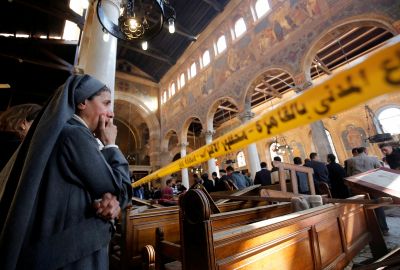
Cairo, Apr 9: At least 36 people were killed and over 140 others injured today in twin blasts targeting Coptic churches packed with worshippers who had gathered for Palm Sunday mass in Egyptian cities of Tanta and Alexandria.
The first blast took place in the Coptic church of Mar Girgis, also known as St George, in the Nile delta city of Tanta, about 120 kilometres from Cairo, killing 25 people and injuring 71, according to a statement by the Health Ministry.
Security sources said the primary investigations suggest that a person put an explosive device inside the church during the Christian prayers celebrating the Palm Sunday.
However, other sources suggest that the attack was carried out by a suicide bomber.
Hours later, the second explosion took place in Alexandria's Manshyia district when a suicide bomber detonated an explosive device near Saint Mark's Church.
Citing eyewitnesses, Ahram Online said that an explosion has been heard near Saint Mark's Church in Manshyia district near downtown Alexandria.
At least two were killed and 21 injured in the blast near Saint Mark's Church in Manshiya, state TV reported.
Egypt's Coptic church said Pope Tawadros II, Pope of Alexandria, was leading Palm Sunday Mass just before the explosion.
Local media reported that most of the injured are from security forces outside the church and passersby.
There was no immediate claim of responsibility.
President Abdel Fattah el-Sisi called for a National Defence Council meeting in response to the attack.
The National Defence Council is made up of the prime minister, the speaker of parliament, the minister of defence and the commanders of the Egyptian armed forces, and is chaired by the president.
President El-Sisi ordered the opening of military hospitals to receive the injured.
Al-Azhar, the world's highest seat of Sunni Islamic learning, strongly condemned the attacks, calling it an "outrageous crime" against all Egyptians.
"This terrorist attack is devoid of all the principles of humanity and civilisation," it said in a statement.
The explosion come weeks before the visit of Pope Francis to Egypt on April 28-29.
Palm Sunday falls on Sunday before the Easter. The feast commemorates Jesus' triumphal entry into Jerusalem, an event mentioned in each of the four canonical Gospels.
Coptic Christians make up about 10 per cent of Egypt's population of 85 million.
Egypt's Christian minority has often been targeted by Islamist militants.
Egypt has seen a wave of attacks by militants since 2013 when the military toppled president Mohammed Morsi, an elected leader who hailed from the Muslim Brotherhood, and launched a crackdown against Islamists.





Comments
Add new comment